
Question: If you had to choose between playing a $100 guitar on a $1000 guitar amp…
Or a $1000 guitar on a $100 amp, which would you choose?
Well if you asked this same question to 10 veteran players, it’s a pretty safe bet that all 10 would choose the better amp…
And be totally certain they made the right choice.
Because among the endless number of factors that ultimately determine the tone of an electric guitar…
The amp is regarded by most players as the single most important of all. So in this ultimate guide, I’m going show you everything you need to know on the topic.
First up…
Combo vs Stacked Guitar Amps
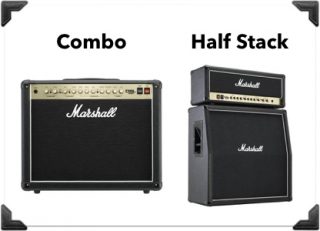
When first comparing amps, you quickly notice that:
- Some come as 1 piece
- some come in 2+ pieces
Now here’s why:
- One-piece amps (combos) – hold both the amplifier and the speakers in a single box.
- Multi-piece setups (stacks) – have separate boxes for each one.
Typically, stacks are used for performing in large venues, mainly because they are capable of higher volumes.
That’s not to say that combo amps aren’t pretty loud themselves…because they are. Combine that with their added portability and lower price, and it’s clear why combos are the MUCH more popular option.
Unless you’ve been playing for a long time, and have tried out dozens of amps over the years…OR there’s a specific reason why you need something as big and loud as a full-stack…there’s a 95% chance that a combo amp is what you should get.
Up next…
Solid State vs Tube Amps: Which Sounds Better?
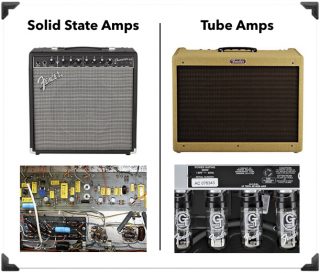
The single most common question players ask when buying their first amp is:
What exactly is the difference between solid-state and tube amps? And which one should I get?
Well here’s how they compare:
In terms of sound, tube amps have a warmer, more textured sound, and are highly-prized for the unique type of natural distortion they create, which can’t quite be duplicated by any other means.
In comparison, solid-state amps have a cleaner, somewhat “colder” sound, which is not necessarily bad in itself…but is definitely less sought-after compared to the tone of tube amps.
However...in terms of performance, since solid-state amps are the newer of the two technologies…
They are cheaper, require less maintenance, are lighter and more portable, and are generally more reliable than tube amps overall.
In some newer amp models, you actually can find hybrids of these two technologies:
- with vacuum tubes used in the preamp,
- and solid-state circuitry in the power amp…
Which essentially gives you that classic tube sound with less of the downsides.
It’s also worth noting that in terms of volume…tube amps are significantly louder than solid-state amps when all other factors are equal (same speakers, wattage, etc).
And this leads nicely into the next topic of discussion….
How Does Wattage Affect Volume?
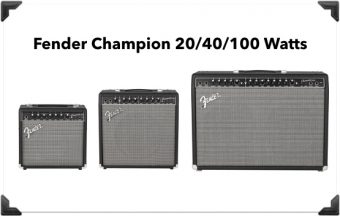
The next most common question players ask when comparing amps is:
How many watts should I get?
And while you might simply assume that:
- more watts = more volume
The truth is actually far more complex, and well beyond the scope of this article.
So instead of showing you a bunch of equations and graphs, I’ll just tell you what you probably care to know:
While you might assume that a 100W amp would be 5x as loud as a 20W amp, it’s actually only around 2x as loud. Which is still loud enough to be used for almost any purpose.
And so…as a VERY GENERAL rule of thumb:
- 50W or greater is better for large-venue performances
- 40W or less is better for practice, studio, and small to mid-size venues
And if you want an exact number to start with…20W or 30W will most likely offer maximum versatility for the average player.
If you’re choosing a tube amp, it’s worth noting that lower wattage guitar amps allow tubes to “saturate” and distort without having to crank up the volume too loud.
So as another VERY GENERAL rule of thumb with tube amps…it’s better to lean towards the lower wattages.
Up next…
How Big Should My Guitar Cabinet Be?
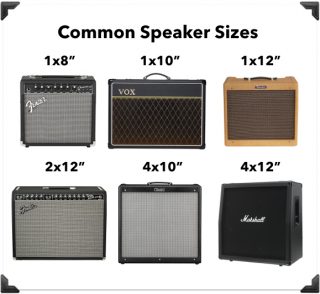
As many guitar experts would agree…
The number and size of the speakers on a particular guitar amp is more influential in tone and loudness than the amplifier itself.
As you might expect:
- LARGER speakers = more loudness
- MORE speakers = more loudness
However, bigger isn’t always better, since smaller speakers are actually better at reproducing high frequencies (while larger speakers are better at reproducing low ones).
In terms of size, speakers can be as small as 2″ in diameter, and go all the way up to 15″.
But the vast majority come in 1 of 3 sizes:
- 8″
- 10″
- 12″
In terms of number, the typical options are:
- 1
- 2
- 4
For practicing, one 8″ speaker is standard, and can actually be preferable since less bass means you are less likely to annoy your neighbors.
For performing…one or two 10″ or 12″ speakers is generally most suitable in small venues. While 4×10″ or 4×12″ work better for larger venues, and often come in their own dedicated cabinets.
For recording, pretty much any combination can be used, depending on the tone you are searching for.
Up next…
Digital Modeling Amps vs Analog Amps
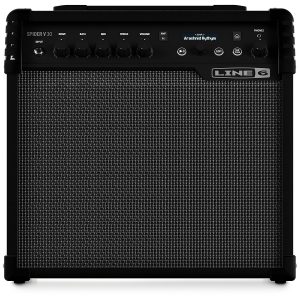
While classic analog amps can have a limited number of effects included, such as reverb and tremolo…
With newer guitar amps, you can often get so much more…
Thanks to today’s advancements in digital modeling technology.
Typically, with many of today’s low-mid priced solid state amps, you now get some variation of the following 2 features:
- Digital effects processing – which can potentially replace all other external effects from pedalboards and rack units.
- Classic amp modeling – which can emulate the sound of character of much more expensive tube amps using digital processing.
It almost sounds too good to be true, doesn’t it? Well in a way, it sort of is.
While their versatility might make them ideal for practice and casual jam sessions…professionals who can afford whatever they want will generally choose NOT to use them.
The reason is…a digital emulation of the “the real thing” will never sound quite as good as the actual “real thing” (or at least not yet anyway).
So in the recording studio especially, where sound quality is the priority…a nice plain tube amp is still widely-regarded as the ideal option.
And in cases where a tube amp is NOT an option, and modeling is the only other choice…you might be better off using guitar amp modeling software instead…
- which is cheaper than a modeling amp,
- offers far more tonal options,
- and takes up zero space in the studio.
Up next…
Open Back vs Closed Back Guitar Cabinets
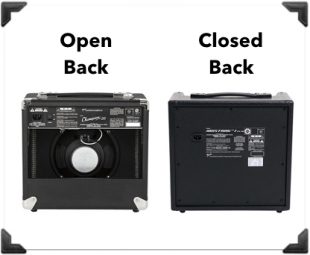
Cabinet construction is one of those features that deserves far more attention than it normally gets.
Because…depending on several factors including:
- type of wood
- thickness
- general craftsmanship
The cabinet itself can have as much of an effect on the resulting tone as either the guitar amps or speakers.
However…in terms of actual decisions to make…there is only one: Open back? Or closed back?
As a rule of thumb:
- Open back guitar cabs – have a more ambient, non-directional sound, with greater emphasis on high frequencies, and a less focused low-end.
- Closed back guitar cabs – have a more focused, directional sound (since it only projects the sound forward), which generally yields a stronger bass and midrange presence.
In the studio, open back cabinets are often prefered, since they offer more options with mic placement.
On stage, open back cabinets are nice for the performers, because they can hear themselves better, especially with no monitoring. But closed back cabinets are nice for the sound guys, who would rather not deal with competing sound coming out the back.
Up next…
The Top Guitar Amps We Recommend
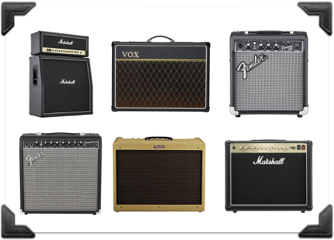
By this point, you already have a deeper understanding of guitar amps than 99% of players.
So the only thing left to do is use your newfound knowledge to choose an amp that suits you.
For the majority of folks reading this article, who simply want the cheapest possible practice amp to get started, there are really only two obvious choices:
- Fender Frontman 10G – (Amazon/Sweetwater/Thomann)
- Vox Pathfinder – (Amazon/Sweetwater/Thomann)
If however…you’d like to spend a bit more ($100-300), and get something suitable for both practice and possibly performing as well…
Here is a good list of popular solid-state amps to check out:
- Fender Champion (20/40/100)
- Fender Mustang (20/100/150)
- Marshall MG (10/15/30/50/100)
- Vox Valvetronix (20/40/100)
As you’ll notice, all the guitar amps I’ve recommended so far have been either Fender, Vox, or Marshall.
Which is no coincidence, since these 3 brands alone are probably responsible for over 90% of the most classic amps in music history.
While there are plenty of other brands that make amps which are arguably just as good, there’s really no good reason to stray away from the classics…
Many of which, are some version of the tube amps I recommend below:
- Fender Blues Deluxe – (Amazon/Sweetwater/Thomann)
- Fender Hot Rod Deluxe – (Amazon/Sweetwater)
- Marshall DSL40C – (Amazon/Sweetwater)
- Fender Twin Reverb – (Amazon/Sweetwater/Thomann)
- Fender Princeton Reverb – (Amazon/Sweetwater/Thomann)
- Fender Deluxe Reverb – (Amazon/Sweetwater/Thomann)
If the best of the best is what you want, any of the previous amps should suit you just fine.
And finally…
Are Mini Guitar Amps Any Good?
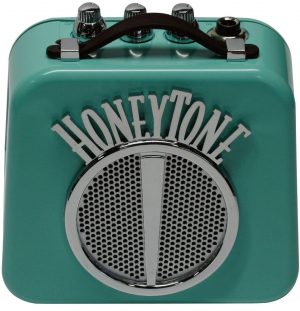
To conclude this post, just for fun, I’d like to show some fun little toys known as mini guitar amps.
While you obviously wouldn’t use them for real practicing…
They’re still a cool little novelty, which you might use:
- To give as a gift…
- To wow your friends at parties…
- Or perhaps to jam along with the radio on your next road trip
It’s true…they don’t sound great. But you shouldn’t expect them to…since they are so tiny and cheap after all.
Instead, the only thing to ask yourself when choosing one is: Which one looks coolest?
So if you’re interested, check out the links below and decide for yourself:
- Vox amPlug – (Amazon/Sweetwater/Thomann)
- Honeytone N-10 – (Amazon/Sweetwater/Thomann)
- Fender ’57 Mini Twin – (Amazon/Sweetwater/Thomann)
- Fender Mini Deluxe – (Sweetwater/Thomann)
- Fender Mini Tonemaster – (Amazon/Sweetwater/Thomann)
By the way, if you found this post useful, I highly recommend joining our free Home Recording Secrets email newsletter where you’ll discover….
- How to Get Your First Studio Up and Running in a Single Weekend
- How to Avoid Wasting Thousands of Dollars on Unnecessary Pointless Purchases
- How to Get a “Million Dollar” Pro Studio Sound in a “Thousand Dollar” Home Studio
- PLUS… All Sorts of Other Amazing Insider Secrets Revealed
And it’s totally FREE! Click here and Enter Your Email to Sign Up.
More Guitar Posts in This Series:
Electric Guitar | Acoustic Guitar | Bass Guitar | Amps | Pedals | Cables | Pickups | Bass Strings | Bass Amps | Bass Pickups | Classical Guitars | Acoustic Pickups | Direct Boxes | Cases | Picks | Slides | Straps | Tuners | Stands | Strings | Capos | Tabs | Guitar Accessories